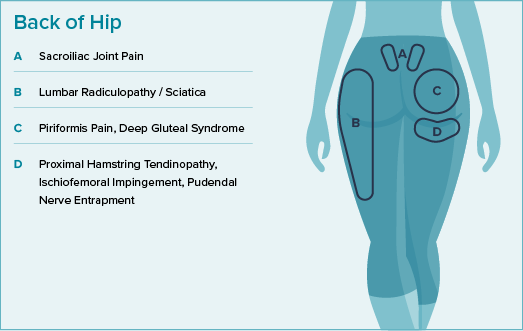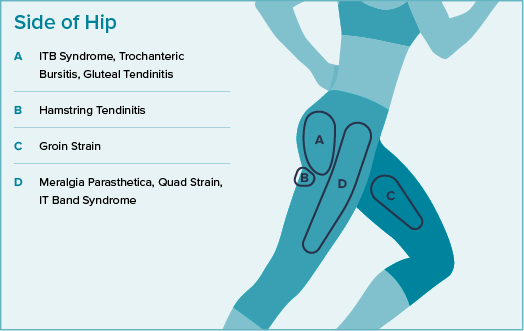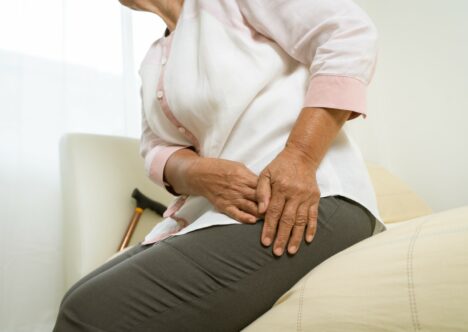Use our convenient online scheduler to book an appointment now.

Table of Contents
Hip pain can be a perplexing experience, with discomfort manifesting in various locations around this complex joint. Understanding the potential causes of pain in different hip areas is crucial for effective diagnosis and treatment. In this blog, we’ll explore three distinct locations of hip pain—front, back, and side—shedding light on possible issues and conditions associated with each.
Front Hip Pain
Embarking on the journey to understanding front hip pain unveils a complex landscape where discomfort comes in various forms and conditions. The front of the hip, a crucial junction for mobility and stability, becomes a focal point for various potential issues.

a.) Femoroacetabular Impingement (FAI), Labral Tear, Femoral Neck Fracture, Osteonecrosis, Synovitis, Chondromalacia:
FAI occurs when there’s abnormal contact between the hip’s ball and socket, leading to pain and limited motion.
Labral tears involve damage to the cartilage surrounding the hip socket, often caused by repetitive motion or trauma.
Femoral neck fractures, osteonecrosis, synovitis, and chondromalacia are diverse conditions affecting the front hip, each requiring unique treatment approaches.
b.) Sports Hernia, Inguinal Hernia, Inguinal Nerve Entrapment:
Sports hernia, not a true hernia, causes pain in the groin area due to soft tissue injury.
An inguinal hernia involves a protrusion of abdominal contents into the groin, while inguinal nerve entrapment causes pain due to nerve compression.
c.) Hip Flexor Tendinitis:
Inflammation of the hip flexor tendons, often stemming from overuse or muscle imbalances.
d.) ITB syndrome, Trochanteric Bursitis, Gluteal Tendinitis:
ITB syndrome is characterized by outer hip pain due to friction of the iliotibial band.
Trochanteric bursitis and gluteal tendinitis involve inflammation of the bursa and tendons around the hip.
e.) Osteitis Pubis, Athletic Pubalgia:
Osteitis pubis is inflammation of the pubic symphysis, while athletic pubalgia refers to chronic groin pain in athletes.
f.) Adductor Strain:
Strain in the adductor muscles, often resulting from sudden movements or overexertion.
g.) Quadricep Strain, Meralgia Parasthetica:
Quadricep strain and meralgia parasthetica affect the front of the hip, causing pain and sensory disturbances.
Back of Hip Pain
The back of the hip, a pivotal junction connecting the spine to the pelvis, becomes a focal point for various conditions. Pain in the back of the hip unravels a distinctive tapestry of discomfort where the intricacies of the sacroiliac joint, lumbar spine, and deep gluteal structures converge.

a.) Sacroiliac Joint Pain:
Pain in the sacroiliac joint, connecting the spine to the pelvis, is often associated with inflammation or dysfunction.
b.) Lumbar Radiculopathy/Sciatica:
Pain radiating from the lower back down the leg is commonly caused by sciatic nerve compression.
c.) Piriformis Pain, Deep Gluteal Syndrome:
Piriformis pain arises from the irritation of the piriformis muscle, while deep gluteal syndrome involves compression of nerves and vessels in the buttock.
d.) Proximal Hamstring Tendinopathy, Ischiofemoral Impingement, Pudendal Nerve Entrapment:
Conditions affecting the back of the hip include proximal hamstring tendinopathy, ischiofemoral impingement, and pudendal nerve entrapment.
Side of Hip Pain
The side of the hip, often implicated in activities like running or cycling, hosts a range of potential issues. Exploration of lateral hip pain opens the door to a diverse spectrum of discomfort, where the lateral aspects of this crucial joint become a focal point for various conditions.

a.) ITB syndrome, Trochanteric Bursitis, Gluteal Tendinitis:
These conditions also cause lateral or outer hip pain and may be exacerbated by activities like running or cycling.
b.) Hamstring Tendinitis:
Inflammation of the hamstring tendons leads to pain on the side of the hip.
c.) Groin Strain:
Injury to the muscles in the groin area often occurs during activities that involve sudden changes in direction.
d.) Meralgia Parasthetica, Quad Strain:
Conditions affecting the side of the hip lead to sensory disturbances (meralgia parasthetica) or strain in the quadriceps muscles.
Conclusion
Understanding the diverse causes of hip pain in different locations is essential for effective diagnosis and treatment. With the help of our hip pain location diagram, you can narrow down what may cause your hip pain.
If you are experiencing persistent discomfort, don’t hesitate to seek professional help. Request an appointment with one of Town Center Orthopaedics’ healthcare professionals for personalized guidance based on your unique situation. Your journey to hip pain relief starts with accurate identification and targeted treatment.
Join our Mailing List
TCO provides patients with orthopedic problems the trusted resources and patient-centered advice they need to “Feel Better. Move Better. Be Better.”
© 2024 Town Center Orthopaedics | All Rights Reserved


